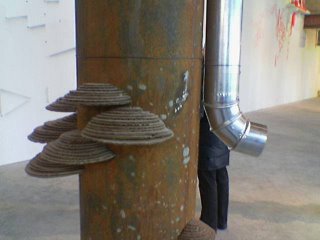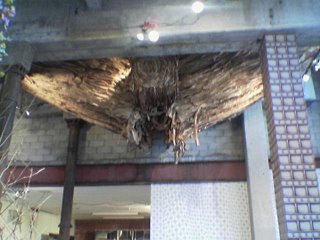This is from my expedition on Friday...
Went out today for a day in the city. Considered going to see the Biennial, but after seeing the following two shows, which I really enjoyed, I didn't want to ruin my mood. The first show, Ernesto Caivano at Guild & Greyshkul was a wonderful surprise. I knew it was on my list of things to see (thanks ArtCal), but couldn't remember why or what the work might be. The brilliance of the work was refreshing. The press release (I read it after viewing the work) was in itself a work of art, but since G&G doesn't have it on its site, I will pull some text from an earlier review by Douglas Max Utter in Angle Magazine:
In a distant, heavily wooded dimension, lovers are separated for a thousand years. As the centuries pass each slowly realizes different potentials of the mind and spirit: he becomes a knight, intimately in tune with the natural world. She becomes a spaceship—reason and its achievements incarnate. These two halves of a neo-Platonic world soul communicate through birds known as philapores, which Caivano says means “love of pores.” He also remarks they cannot fly but are able to pass through dense matter. Inscribed on their feathers is critical information and coding, which passes between the lovers with much difficulty and effort. The salvation of the natural and spiritual environment is at stake.
 The work, all ink on paper, ranged in size from about 4"x4" to about 47"x139". The subject matter was elusive, but not unattainable. The small drawings looked like extracts from a Victorian botany reference book. The larger drawings incorporated references to landscape and technology, organic flora and strange dust clouds. The drawings contained large masses of blackness, topped with light, fine and precise renderings, several of the drawings also included technicolor aspects which aided the link to futurism. (I was most fascinated by the deftly and delicately rendered clouds of minuscle 'dust' - for lack of a better term).
The work, all ink on paper, ranged in size from about 4"x4" to about 47"x139". The subject matter was elusive, but not unattainable. The small drawings looked like extracts from a Victorian botany reference book. The larger drawings incorporated references to landscape and technology, organic flora and strange dust clouds. The drawings contained large masses of blackness, topped with light, fine and precise renderings, several of the drawings also included technicolor aspects which aided the link to futurism. (I was most fascinated by the deftly and delicately rendered clouds of minuscle 'dust' - for lack of a better term).
I also visited Sumi, a gallery on West Broadway. Sandwiched in between the high octane shops of Soho, this gallery offers a wonderful respite from the cacophony outside its doors. The show was entitled 'artintme' and was brought to my attention by my friend James Jack, who had work in the show. The curatorial preface of the show was art that is intimate and personal in both its creation and presentation. All of the work succeeded in representing this thesis in a variety of ways - all bringing to bear their own cultural identity and personal history on the work. I also (imho) felt that there was a strong secondary curatorial thesis at play - an idealized sense of serenity within an object or mark.
Most of the works fit within this secondary theme and worked well, but there were a few works which, while they fit within the stated curatorial theme, because of their disonance within the secondary unstated theme presented a distraction from the overall presentation of the show. The works were interesting on their own level, but the curatorial oversight left them out of synch with the rest of the show.
 The works which did work together did so on a variety of levels. They included finely crafted works of intensity by Ilan Katin, Jasmine Sian and Regine Polenz. Katin's books of line drawings are intricate marks with seem to reference the passing of time. Polenz' comic book style drawings and her sculptural abstraction of them remove the frame of reference and leave the viewer lost in non-narrative. Sian creates floral drawings (remniscient of wallpaper or upholstery) and filigree cut outs from ultr-thin deli-paper, rendering that which is normally a discarded bit of refuse into a refined object of fragility.
The works which did work together did so on a variety of levels. They included finely crafted works of intensity by Ilan Katin, Jasmine Sian and Regine Polenz. Katin's books of line drawings are intricate marks with seem to reference the passing of time. Polenz' comic book style drawings and her sculptural abstraction of them remove the frame of reference and leave the viewer lost in non-narrative. Sian creates floral drawings (remniscient of wallpaper or upholstery) and filigree cut outs from ultr-thin deli-paper, rendering that which is normally a discarded bit of refuse into a refined object of fragility.Other artists, James Jack, Bodo Korsig, Gyoko Yoshida and Brad Paley explored the visual representation of the mark, Jack's work, while beautiful in its epemerality (they were photos of calligraphic marks made with water on rocks) suffered from a lack of explanatory text, poor display (they deserved to be treated more preciously) and the strange curatorial decision which placed his work on one side next to some of the distracting work (see above) which was brightly colored. On the other side of his work though was work with whom he shared the affinity for delicacy. Yoshida's work consisted of barely there marks on sheer organza (which - since we are offering opinions - suffered itself from the artists decision to place this spare and delicate work on bulky and distracting wooden frames). Kosig explores the mark through stark and reference laden black wall mounted sculptures. Paley's work utilized a fascinating tool called a text arc to analyze 'The Tale of Genji' to create a visual representation of the weight of words and their use within the book.
So you can see how these two escapist (whether through a fantastical world of arcadia and utopia or through acts of meditative intimacy) would leave me unprepared for the whitney. I, too, am tired of the violence - but how to react? Do we hide under a rock, provide a salve or express yourself in simplistic terms? Me I prefer to find a way to create work which will change the world by affecting positive action.
Technorati tags: art, galleries, drawings, sculptures















